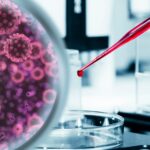The Australian virologist on the WHO trip to Wuhan says the results of the visit weren’t surprising, but the personal attacks that followed were.
Whatever the origins of covid-19 were, Professor Dominic Dwyer – the Australian researcher who accompanied the recent WHO field visit to Wuhan – believes a major opportunity to stop the pandemic in the early stages was missed.
By releasing the SARS-CoV-2 genetic sequence two weeks after it was initially available, instead of straight away, the Chinese Centre for Disease Control missed the opportunity to get ahead of the virus, Professor Dwyer told the Royal College of Pathologists of Australasia conference in Sydney.
“One might argue that an almost two-week delay in making a sequence available clearly compromises things like being able to develop a diagnostic test, and get some understanding, perhaps of future treatments or even vaccines,” the University of Sydney virologist said.
“I think a two-week delay in that is unforgiveable.”
Professor Dwyer was part of a team of 34 experts sent to look at the origins of covid, specifically the clinical epidemiology, the molecular epidemiology and the role of animals.
Importantly, he said, the trip was not about assessing the responses of individual countries to the pandemic, but instead about understanding its origins.
Going in, there were four main hypotheses about the origins of the respiratory virus:
- that it came from a bat to an intermediary host to a human,
- that it was transmitted directly from bats to humans,
- that it came from frozen food,
- or that it was accidentally or deliberately leaked from the Wuhan Institute of Virology.
While he didn’t explicitly say that frozen food was ruled out as the origin of covid, Professor Dwyer pointed out that viruses more commonly move from an animal host into a human.
As for the “lab leak” theory?
The Wuhan Institute of Virology, he said, was a terrific laboratory.
“In discussions [with the lab workers] about how things were handled … we couldn’t find any evidence, including serologic evidence from the workers, that anything had happened in that laboratory,” Professor Dwyer said.
“Not that that stops people from having an opinion.”
While Wuhan’s Huanan Seafood Market was linked to about half of the first few hundred covid cases, it was unclear if the wet market was the source of the disease or just an amplifying event.
“[Walking around the market], we could clearly see open drains, narrow corridors, dark cages and pits where animals, fish and reptiles were stored on the left-hand side – and on the right-hand side, sleeping quarters in almost direct connection with the products being sold,” Professor Dwyer told audiences.
“You couldn’t script a better place to have an outbreak of anything, let alone a new virus.”
When asked by the WHO team whether there were wild animals in the market, the Chinese government said it was illegal to trade in wild animals.
“Which is different to saying there aren’t wild animals in the market,” Professor Dwyer said.
Epidemiologically, the first cases were all also clustered around the market, making Professor Dwyer reasonably confident that the Huanan market was the likely source of the virus.
The location of the market is very built up and densely populated.
“I think it’s just more evidence leaning towards [the theory] that something’s gone from the market, into the heavily densely populated [area] nearby,” Professor Dwyer said.
While the conclusions of their investigation weren’t exactly surprising to him, the media spectacle surrounding his trip was.
He received messages and social media comments attacking his work and was even told he was a “traitor” to Australia.
“The more serious part about this is the attack on science,” Professor Dwyer told the RCPA conference.
While working out how to engage with media and social media was not in the scientist or doctor “playbook”, Professor Dwyer said it was an important skill to learn.
The RCPA’s Pathology Update 2022 was held from 4-6 March at the Sydney International Convention Centre




